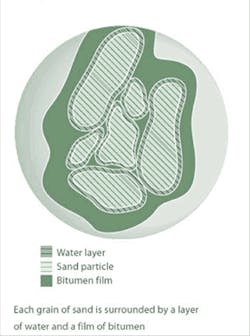by Ferdous K. Noman
• Economic and environmental implications – and the water use dilemma – of Alberta’s Athabasca oil sands region call for a more sustainable approach to extraction
Oil sands consist of a mixture of crude bitumen (a semi-solid form of crude oil), silica sand, clay minerals and water. This article summarizes the economic and environmental implications of Alberta’s oil sands, states current and emerging extraction technologies, notes associated water issues and suggests potential solutions.
Economic Implications of Alberta’s Oil Sands
Alberta has huge deposits of oil sands that lie under 140,200 square kilometers of the province. These deposits are separated into three regions – Peace River, Athabasca (Fort McMurray area), and Cold Lake (north of Lloydminster), as shown in Figure 2.
According to the Canadian Association of Petroleum Producers (CAPP), the 2006 industry investment in Alberta’s oil sands totaled about $14 billion. The government of Alberta acknowledges the province’s oil sands reserve is considered one of the largest in the world, containing 1.7 trillion barrels of bitumen initially in-place. Of this total, 173.7 billion barrels are considered to be the remaining established reserves. It’s believed this amount is recoverable using current technology. The Alberta Department of Energy estimates about 2% of the initial established resource has been produced to date.
Yet environmental implications associated with development of the oil sands are enormous from a sustainability perspective.
Environmental Implications
The ecological challenge associated with oil sands development includes impact on air, water, land and biodiversity. It’s said oil sands operations involve unsustainable water usage and enormous amounts of greenhouse gas (GHG) emissions to the atmosphere. It also has done unalterable damage to the boreal forests.
The Pembina Institute and the World Wildlife Fund recently graded 10 Alberta oil sands mining companies against environmental performance. They were graded against factors including environmental management, air emissions, land impacts and water usage. Average score of mines assessed was 33%. Albian Sands Muskeg River mine scored the highest – 56%. Syncrude and the proposed Synenco Northern Lights Mine scored the lowest – 18%. In this study, a high percentage represents a high grade and doesn’t necessarily imply that the company is environmentally conscious.
Between 2 to 4.5 volume units of water are used to produce each volume unit of synthetic crude oil (SCO) in an ex-situ mining operation. Despite recycling, almost all of it ends up in tailing ponds. In steam assisted gravity drainage (SAGD) operations, 90-95% of the water is recycled and only about 0.2 volume units of water is used per volume unit of bitumen produced, according to 2006 National Energy Board statistics.
Bitumen Extraction Processes
Mining and in situ are the two types of oil sands production methods. Bitumen is extracted by applying various processes as discussed in the following section.
Dr. Karl Clark, working with Alberta Research Council in the 1920s, developed the original process for extraction of bitumen from the sands. Current in situ processes that apply thermal energy to heat the bitumen for extraction include:
- Thermal (steam) injection through vertical or horizontal wells such as cyclic steam stimulation (CSS)
- Pressure cyclic steam drive (PCSD)
- Steam assisted gravity drainage (SAGD)
Emerging Extraction Processes
Emerging extraction processes include vapour recovery extraction (VAPEX) and toe-to-heel air injection (THAI). Instead of steam, hydrocarbon solvents such as liquefied ethane or butane are applied in the VAPEX process. Although more expensive, this process is considered more energy efficient and some partial upgrading of the bitumen to crude oil occurs right in the sands.
THAI, also known as “fire flooding,” requires a vertical air injection well with a horizontal production well. The bitumen is ignited to burn heavier oil and lighter components are pumped out through the production well. The heat from the fire upgrades some of the heavy bitumen into lighter oil giving it the advantage not requiring energy to create steam.
Water & Environmental Impacts
Alberta’s oil sands industry utilizes enormous quantities of water, although quantities vary with the type of extraction process employed. Water use is regulated under Alberta’s Water Act through a licensing and monitoring system.
The Alberta Energy & Utilities Board (EUB) expect the production of bitumen from oil sands to more than double in the decade 2004-2014. Thus demand for water will also increase. The Pembina Institute notes there’s a direct relationship between the quantity of water in a river and health of its fishery. Drawing too much water can leave irreversible changes.
Approved oil sands operations are currently licensed to divert 359 million m3 of water from the Athabasca River. This is more than twice the volume of water required to meet annual municipal needs of the city of Calgary, with a population of nearly a million people.
Water use has been identified as one of the top four challenges for oil sands mining operations by the Alberta Chamber of Resources. Clearly a solution is essential for sustainable water resource use for development of oil sands in Alberta. Although there are technologies that treat wastewater discharged from the processes, long term sustainability is highly dependent on trends toward wastewater recycle and reuse.
Even with wastewater recycling, portions of the water used still end up in tailing ponds. Tailings take up about twice the volume of originally extracted tar sand. They typically include residual metals, acids, hydrocarbons, and related unknown process chemicals. This pond water can be detoxified by rapid chemical treatments which involve coagulation at pH between 4.5 to 5.0. That’s then followed by flocculation with an anionic polyelectrolyte. Alternately, tailings pond water can be stored in shallow well aerated pits for one to two years. During this period, natural processes can result in significant water-quality improvement. Spray freezing prior to or in conjunction with the tailing ponds is also being explored as a separation option for processed water.
Produced water has to be treated before it can be used to generate steam for the in situ oil recovery process. Wastes generated from this treatment process include sludge and filter waste. They’re either put into deep wells or sent to landfills where there’s a risk they may eventually leach into fresh groundwater. Established and emerging technologies to treat wastewater include sedimentation, separators, sand filter, adsorption, aeration, ion exchange, activated carbon, distillation, microfiltration, nanofiltration, reverse osmosis and electrodialysis.
Potential Solutions
Potential solutions to address the use of water and mitigate the associated environmental impacts lie in alternative options. These can include application of VAPEX or THAI processes or recycling and reusing used water. A number of other technologies also are being evaluated to reduce water use during processing. The Pembina Institute, in its 2006 report entitled “Troubled Waters, Troubling Trends,” identifies a number of alternative options including:
- Dry Tailings Technologies – The “BITMIN” extraction technology will be piloted on a commercial scale by UTS Energy Corp. and Petro-Canada at the Fort Hills site. This dry tailings technology can bring significant improvements for water use requirements.
- Solvents and Heats – Suncor’s pilot project near the Firebag SAGD project and Petro-Canada’s Mackay River project uses solvents with steam. The Pembina Institute report states that a process combining the application of coke or bitumen plus oxygen as heating fuel is being developed. This process recycles hot solvent and stores greenhouse gases, such as CO2, or pollutants, such as SO2, in the reservoir. Ultimately, the process uses less water and fuel compared to steam-assisted methods.
- Electrical Heaters to Warm Bitumen – In 2004, Shell completed drilling 30 wells from two well pads at its Peace River in situ operation to test the use of electrical heaters to gradually heat the reservoir and convert the heavy oil to lighter crude oil underground. This option is still being explored.
- Electro-magnetic Stimulation – Water use can potentially be eliminated by applying microwave-frequency heating to heat reservoirs. Further research is required in this area before a pilot project can be developed.
Conclusion
Oil sands mining in Alberta to extract bitumen is expected to grow in the foreseeable future. Environmental advocates claim the excessive use of water is unsustainable with negative impacts on the local ecosystem. A number of technology options for extraction of bitumen from oil sands that require less water compared to other conventional processes do exist. A combination of extraction technologies and use of recycled water in the extraction process provides immediate solutions to increase the efficiency of water use. Exploration in alternate technologies would provide a long-term solution to ensure sustainable use of water resources.
About the Author: Ferdous K. Noman is a former research analyst with Palo Alto, CA-based global growth consulting company Frost & Sullivan’s North American Environmental Technologies practice, monitoring and analyzing trends, technologies and market dynamics in water and wastewater treatment. Earlier, he was a policy adviser with the Ontario Ministry of the Environment’s Air Policy & Climate Change Branch, recommending sustainable business management practices for companies such as Enbridge Gas Distribution, Unilever Canada and Suncor Energy. Contact: [email protected] or www.frost.com
Chart 1. Alberta oil sands - quick facts
- Today, all operating oil sands mines are linked with upgraders that convert the bitumen to synthetic crude oil
- In situ oil sands production is similar to that of conventional oil production where oil is recovered through wells
- The Alberta Energy and Utilities Board estimates that 82% of the total bitumen ultimately recoverable will be with in situ techniques
Chart 2. Regional environmental issues pertaining to extraction of bitumen from oil sands
- 66% of water allocated in the Athabasca Region is for oil sands mining
- Land that was once boreal forest and wetlands is now covered by 50 km2 of toxic tailings
- The 2005 water allocation for oil sands mining & productions was 359 million m3
- 10% of water taken from the Athabasca Region form mining return to the river; the rest is used/diverted to tailing ponds




